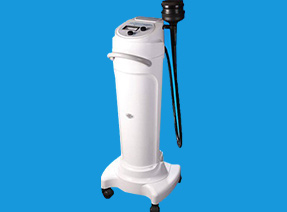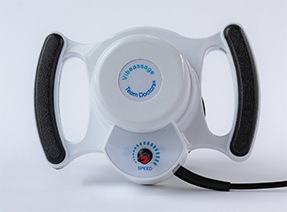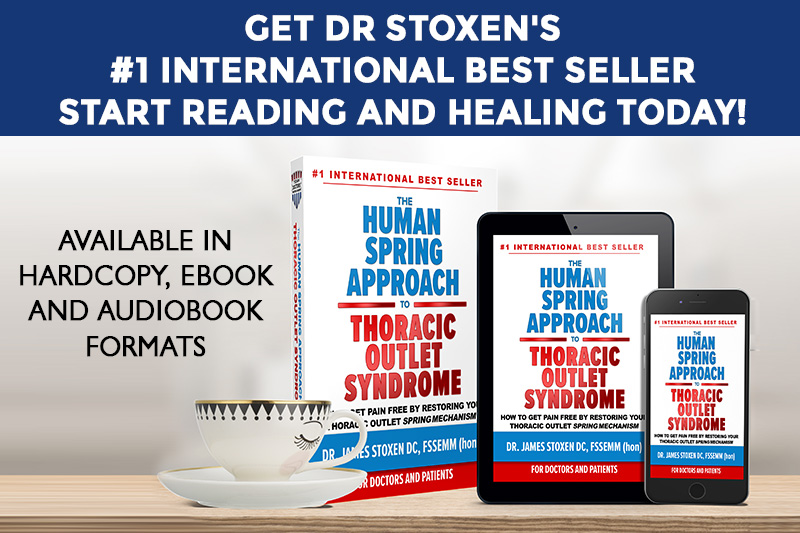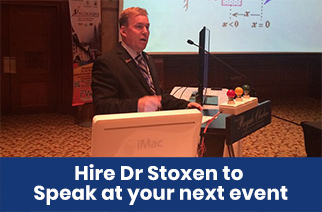THE HUMAN SPRING APPROACH TO
THORACIC OUTLET SYNDROME
by Dr James Stoxen DC., FSSEMM (hon) FWSSEM
GLOSSARY
M
magnetic resonance angiography – a group of techniques based on magnetic resonance imaging to image blood vessels.
magnetic resonance imaging – a medical imaging technique used in radiology to form pictures of the anatomy and the physiological processes of the body in both health and disease.
magnetic resonance venography (MRV), (Venous Scintillation Scans, positron emission tomography (PET)) – a painless exam that uses high-frequency sound waves (ultrasound) to capture images of internal views of veins that return blood to the heart.
malunion – when a fractured bone doesn’t heal properly.
manipulation – the act, process, or an instance of manipulating especially a body part by manual examination and treatment; especially, adjustment of faulty structural relationships by manual means (as in the reduction of fractures or dislocations or the breaking down of adhesions).
manipulative therapy (manual therapy, manipulative therapy) – is a physical treatment primarily used to treat musculoskeletal pain and disability; it most commonly includes kneading and manipulation of muscles, joint mobilization and joint manipulation.
manual lymphatic drainage – a type of massage based on preliminary evidence which is hypothesized to encourage the natural drainage of the lymph, which carries waste products away from the tissues back toward the heart.
manual therapy – a physical treatment primarily used by physical therapists, physiotherapists, occupational therapists, chiropractors, massage therapists, athletic trainers, osteopaths, and osteopathic physicians to treat musculoskeletal pain and disability.
massage – the rubbing and kneading of muscles and joints of the body with the hands, especially to relieve tension or pain.
massage therapist – A person who practices therapeutic massage.
massage therapy – the scientific manipulation of the soft tissues of the body, consisting primarily of manual (hands-on) techniques such as applying fixed or movable pressure, holding, and moving muscles and body tissues.
maximum load capacity – the maximum load that a structure can safely carry
maximum medical improvement (MMI) – occurs when an injured person reaches a state where his or her condition cannot be improved any further or when a treatment plateau in a person’s healing process is reached.
mechanical energy – the sum of kinetic and potential energy in an object that is used to do work. In other words, it is energy in an object due to its motion or position, or both.
mechanical traction – the application of a sustained pull on a body part.
mechanoreceptors – (Pacinian corpuscle, Meissner’s corpuscles, Merkels discs and Ruffini endings) – a mechanoreceptor is a sensory receptor hat responds to mechanical pressure or distortion. Normally there are four main types in glabrous mammalian skin.
median nerve compression – the culprit behind the sensory pain and motor impairments collectively known as carpal tunnel syndrome (CTS). The carpal tunnel is a passageway in the wrist that contains the median nerve and tendons at the base of the hand.
median nerve entrapment (median nerve compression) – compression of the median nerve as it passes under the muscles of the forearm leading to numbness in the thumb, the index finger, the middle finger, and half of the ring finger.
Medicaid – a “government insurance program for persons of all ages whose income and resources are insufficient to pay for health care expenses.
medical history – information gained by a physician by asking specific questions, either of the patient or of other people who know the person and can give suitable information, with the aim of obtaining information useful in formulating a diagnosis and providing medical care to the patient.
Metaxalone [Skelaxin] – muscle relaxant drug used to relax muscle spasms that exacerbate thoracic outlet syndrome.
microtrauma – the general term given to small injuries to the body. Microtrauma can include the microtearing of muscle fibres, the sheath around the muscle and the connective tissue.
middle scalene muscle – the largest and longest of the three scalene muscles. The middle scalene arises from the posterior tubercles of the transverse processes of the lower six cervical vertebrae. It descends along the side of the vertebral column to insert by a broad attachment into the upper surface of the first rib.
military neck – layman’s terminology for a straightening of the normal lordotic cervical curvature.
misdiagnosed – make an incorrect diagnosis of a particular illness.
misdiagnosis – make an incorrect diagnosis of a particular illness.
mistreatment – to treat badly.
mixed thoracic outlet syndrome TOS – a patient with signs and symptoms of more than one form of TOS together. These patients should be described as simply having more than one subtype (eg, VTOS + NTOS).
mobilization – a manual therapeutic technique that fosters movement in stagnant tissues and joints. Spinal mobilization uses massage to break down scar tissue and restrictions that are typically associated with trauma to the soft tissue.
Morley’s sign – tenderness in the supraclavicular fossa.
Mortons neuroma – Morton neuroma is an injury to the nerve between the toes, which causes thickening and pain. It commonly affects the nerve that travels between the third and fourth toes.
motor nerve – a nerve carrying impulses from the brain or spinal cord to a muscle or gland.
multiple crush syndrome – compression or local irritation of a peripheral nerve at more than one site along its course.
multiple sclerosis (MS) – Multiple Sclerosis (Degenerative spinal cord disease). A disorder of the central nervous system marked by weakness, numbness, a loss of muscle coordination, and problems with vision, speech, and bladder control. Multiple sclerosis is thought to be an autoimmune disease in which the body’s immune system destroys myelin.
multitasking – the handling of more than one task at the same time by a single person.
muscle blocks – when muscles like the pectoralis minor, anterior scalene or middle scalene muscle is injected with medication to determine if the symptoms of thoracic outlet syndrome will get better. If they do then some doctors think that muscle must be removed so the symptoms subside.
muscle energy techniques – Muscle Energy Techniques describes a broad class of manual therapy – is a physical treatment primarily used by physical therapists, physiotherapists, occupational therapists, chiropractors, massage therapists, athletic trainers, osteopaths, and osteopathic physicians to treat musculoskeletal pain and disability.
muscle fibers – a muscle cell.
muscle injections – an intramuscular injection is a technique used to deliver a medication deep into the muscles.
muscle manipulation – muscle manipulation (muscle manipulative therapy) is the alignment of muscles, ligaments, tendons, cartilages, blood vessels, nerves and fibrous tissues to parts of the body that have misaligned for one reason or another.
muscle memory – has been used synonymously with, motor learning, which is a form of procedural memory that involves consolidating a specific motor task into memory through repetition.
muscle regeneration – the process by which damaged skeletal, smooth or cardiac muscle undergoes biological repair and formation of new muscle in response to death (necrosis) of muscle cells.
muscle relaxant – a drug that affects skeletal muscle function and decreases the muscle tone. It may be used to alleviate symptoms such as muscle spasms, pain, and hyperreflexia.
muscle spasticity – a condition in which certain muscles are continuously contracted. This contraction causes stiffness or tightness of the muscles and can interfere with normal movement, speech and gait. Spasticity is usually caused by damage to the portion of the brain or spinal cord that controls voluntary movement.
muscle spindle cells – sensorimotor organs located within skeletal muscle. Each muscle spindle is made up of three to five specialized muscle cells known as intrafusal cells. These cells, bundled together by a sheath of connective tissue, lay alongside the rest of the skeletal muscle fibers.
muscle splinting – protective spasm is the brain’s reflexogenic attempt to prevent further insult to injured tissues. By splinting the area with spasm, muscle ‘locking’ effectively reduces painful joint movements.
muscle stiffness – muscle stiffness is a symptom seen when muscles cannot move quickly without accompanying pain and/or spasm. Sufferers have to move slowly.
muscle stimulation – electrical muscle stimulation (EMS), also known as neuromuscular electrical stimulation (NMES) or electromyostimulation, is the elicitation of muscle contraction using electric impulses.
muscle super contractions – muscle contractions that are activated 24 hours per day, which accompany pain.
muscle super contractions – muscle contractions that are activated 24 hours per day, which accompany pain.
muscle tension – Muscle tension refers to the condition in which muscles of the body remain semi-contracted for an extended period. Muscle tension is typically caused by the physiological effects of stress and can lead to episodes of back pain.
muscle tone – the state of partial contraction present in a muscle in its passive state
muscular dystrophy – a hereditary condition marked by progressive weakening and wasting of the muscles.
musculoskeletal conditions – Musculoskeletal conditions are conditions that involve the muscles, bones, tendons, ligaments, joints, and nerves. An example of a musculoskeletal condition is tendinitis.
musculoskeletal disorders – musculoskeletal disorders are injuries or pain in the human musculoskeletal system, including the joints, ligaments, muscles, nerves, tendons, and structures that support limbs, neck and back.
myalgia – myalgia, or muscle pain, is a symptom of many diseases and disorders.
myocardial infarction – A heart attack happens when the flow of oxygen-rich blood to a section of heart muscle suddenly becomes blocked and the heart can’t get oxygen. If blood flow isn’t restored quickly, the section of heart muscle begins to die.
myofascial pain disorder – a chronic pain disorder. in myofascial pain syndrome, pressure on sensitive points in your muscles (trigger points) causes pain in seemingly unrelated parts of your body.
myofascial pain syndrome (MPS) (chronic muscle pain) – a way to describe muscle pain. It refers to pain and inflammation in the body’s soft tissues. MPS is a chronic condition that affects the fascia (connective tissue that covers the muscles).
myofascial release (MFR) – a soft tissue therapy for the treatment of skeletal muscle immobility and pain. This alternative medicine therapy aims to relax contracted muscles, improve blood and lymphatic circulation, and stimulate the stretch reflex in muscles.
myofascial therapy (myofascial release therapy, myofascial trigger point therapy) a type of safe, low load stretch that releases tightness and pain throughout the body caused by myofascial pain syndrome, which describes chronic muscle pain that is worse in certain areas known as trigger points.
myofascial trigger point therapy (myofascial therapy, myofascial release therapy) a type of safe, low load stretch that releases tightness and pain throughout the body caused by myofascial pain syndrome, which describes chronic muscle pain that is worse in certain areas known as trigger points.
myotherapy – a form of manual therapy, which focuses on the assessment, treatment, and rehabilitation of musculoskeletal pain and associated pathologies.

Meet Dr James Stoxen DC., FSSEMM (hon)
President, Team Doctors® Masters Academy
www.drstoxen.com
Dr Stoxen’s Curriculum Vitae
Stay connected to our thoracic outlet syndrome social media sites
1.1k
Members

READ THESE CHAPTERS OF DR STOXENS BOOK FREE HERE!
ARTICLE CATEGORIES
- Testimonials (13)
- Success Stories (13)
- Failed TOS Surgery (1)
- Thoracic Outlet Syndrome (11)
- Compartment Syndrome – Forearm (5)
- Shoulder Replacement Surgery (1)
- Cervical Discectomy (1)
- Cervical Fusion Surgery (1)
- What is TOS? (3)
- Thoracic Outlet Anatomy (1)
- Thoracic Outlet Engineering (1)
- Causes Of TOS (6)
- The TOS Examination (1)
- Diagnostic Tests for TOS (1)
- What Mimics TOS? (1)
- Paget-Schroetter Syndrome (2)
- TOS Surgery (2)
- Posture Tips (1)
- Self Treatment (1)
- What doesn’t work and why? (1)
- What works and why? (1)
- Stretches for TOS (1)
- Exercises for TOS (1)
- Surgery for TOS (1)
- Case Studies (2)
- Chapter Reviews (10)
- Uncategorized (16)
VIDEO TUTORIALS
Subscribe to our newsletter
Team Doctors® Master’s Academy
Professional Development Courses
Launching January 1, 2022!
Team Doctors® Master’s Academy
Patient Self-Care Workshops
Launching January 1, 2022!


















